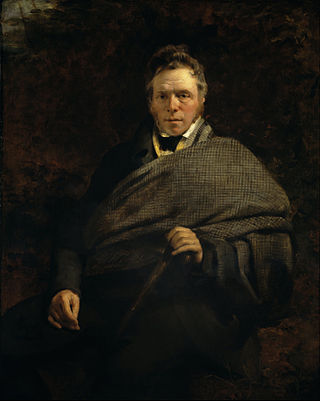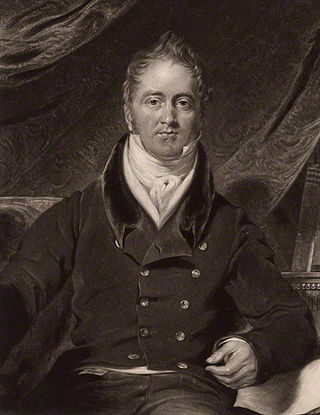Related Research Articles

James Hogg was a Scottish poet, novelist and essayist who wrote in both Scots and English. As a young man he worked as a shepherd and farmhand, and was largely self-educated through reading. He was a friend of many of the great writers of his day, including Sir Walter Scott, of whom he later wrote an unauthorised biography. He became widely known as the "Ettrick Shepherd", a nickname under which some of his works were published, and the character name he was given in the widely read series Noctes Ambrosianae, published in Blackwood's Magazine. He is best known today for his novel The Private Memoirs and Confessions of a Justified Sinner. His other works include the long poem The Queen's Wake (1813), his collection of songs Jacobite Relics (1819), and his two novels The Three Perils of Man (1822), and The Three Perils of Woman (1823).

James Ballantyne was a Scottish solicitor, editor and publisher who worked for his friend Sir Walter Scott. His brother John Ballantyne (1774–1821) was also with the publishing firm, which is noted for the publication of the Novelist's Library (1820), and many works edited or written by Scott.

John Murray was a Scottish publisher and member of the John Murray publishing house. He published works by authors such as Sir Walter Scott, Lord Byron, Jane Austen and Maria Rundell.
Alexander Bald was a Scottish poet.

During the years 1781–1782, at the age of 23, Robert Burns (1759–1796) lived in Irvine, North Ayrshire for a period of around 9 months, whilst learning the craft of flax-dressing from Alexander Peacock, who may have been his mother's half-brother, working at the heckling shop in the Glasgow Vennel. Dr John Cumming of Milgarholm, a provost of Irvine, claimed that he had invited Burns to come to Irvine to learn flax dressing. During this time he made a number of acquaintances, befriended several locals and took regular walks into the Eglinton Woods via the old Irvine to Kilwinning toll road and the Drukken or Drucken (Drunken) Steps. Steps over the Red Burn and back via the site of Saint Brides or Bryde's Well at Stanecastle. Burns had several other connections with the Eglinton Estate and other branches of the Montgomerie family. He probably left in March 1782.

Scottish literature in the nineteenth century includes all written and published works in Scotland or by Scottish writers in the period. It includes literature written in English, Scottish Gaelic and Scots in forms including poetry, novels, drama and the short story.
The Queen's Wake is a narrative poem by James Hogg, first published in 1813. It consists of an Introduction, three Nights, and a Conclusion, totalling over five thousand lines, and there are also authorial notes. The poem presents the contributions, in various metres, of a series of Scottish bards to a competition organised by Mary, Queen of Scots on her arrival in Scotland from France in 1561.

Poems, Chiefly in the Scottish Dialect is commonly known as the first Edinburgh Edition and the partial second setting has become known as the Stinking Edition. It is a collection of poetry and songs by Robert Burns, first Printed for the Author by William Smellie in Edinburgh and published or Sold by William Creech of Edinburgh on the 17 April, an announcement being made in the Edinburgh Advertiser on that date, although the date 21 April 1786 is given by a few authors. The Kilmarnock Edition made Robert Burns Caledonia's Bard whilst the 'Edinburgh Edition' elevated him into a position amongst the world's greatest poets.
The Mountain Bard (1807), containing 21 poems, was James Hogg's first substantial poetical publication.
The Pilgrims of the Sun is a narrative poem by James Hogg, first published in December 1814, dated 1815. It consists of four cantos, totalling somewhat less than 2000 lines. In similar vein to 'Kilmeny' in The Queen's Wake (1813), it tells of a young woman's journey to an ideal world and her return to earth.
Mador of the Moor is a narrative poem by James Hogg, first published in 1816. Consisting of an Introduction, five cantos, and a Conclusion, it runs to more than two thousand lines, mostly in the Spenserian stanza. Set in late medieval Scotland, it tells of the seduction of a young maiden by a charismatic minstrel and her journey to Stirling in search of him, leading to the revelation that he is the king and finally to their marriage and the christening of their son.
Winter Evening Tales is a collection by James Hogg of four novellas, a number of short stories and sketches, and three poems, published in two volumes in 1820. Eleven of the items are reprinted, with varying degrees of revision, from Hogg's periodical The Spy (1810‒11).
Songs, By the Ettrick Shepherd is a collection of 113 songs by James Hogg published in 1831. All except one of the songs had previously appeared in print, mostly either in Hogg's earlier publications or in a range of periodicals.
A Queer Book (1832) is a collections of 26 poems, mostly short narratives, by James Hogg, all but two of which had been previously published, more than half of them in Blackwood's Edinburgh Magazine.
Altrive Tales (1832) by James Hogg is the only volume to have been published of a projected twelve-volume set with that title bringing together his collected prose fiction. It consists of an updated autobiographical memoir, a new novella, and two reprinted short stories.
The Brownie of Bodsbeck (1818) is the first (short) novel by James Hogg. Set in the Scottish Borders in 1685 it presents a sympathetic picture of the persecuted Covenanters and a harsh view of the Royalists led by Clavers (Claverhouse). It draws extensively on local superstitions.

John Richmond (1765–1846) was one of Robert Burns's closest friends and confidants. He was born in Sorn parish at Montgarswood, Ayrshire, Scotland. His father, Henry Richmond, was a merchant in Mauchline and owned Montgarswood Farm that lies near Sorn. This farm passed to James, John's brother, having once been farmed by William Fisher, Burns's Holy Willie.

Robert Ainslie (1766–1838) was a Scottish lawyer, and one of Robert Burns's long-term friends from his Edinburgh days. He was probably the closest confidant of Burns, whom he met first at a Masonic or Crochallan Fencibles event. Ainslie accompanied the poet on the first part of his Border Tour. Robert's father, also Robert, was a lawyer a bailie at Duns and a land-steward on Lord Douglas's Berwickshire estates. Robert married Jean Cunningham on 22 December 1798.
Jean Lorimer (1775–1831) was a friend of the poet Robert Burns, often referred to by him as the "Lassie wi' the lint-white locks" or "Chloris". Lorimer was born at Craigieburn House on a small estate near Moffat and from 1788 to 1791 was a neighbour of Burns when he was living at Ellisland Farm, her father's new farm being at Kemmishall or Kemys Hall, Kirkmahoe Parish, two miles to the south of Ellisland on the opposite bank of the Nith. Burns commented "The Lady on whom it was made, is one of the finest women in Scotland" in a letter to George Thomson, enclosing one of the two dozen or so songs that he wrote for her. They first met when she was a teenager through his excise duties bringing him to their farm.

Poems, Chiefly in the Scottish Dialect was a 'pirated' edition of Robert Burns's work, being published in Ireland without permission from or payment to the author or publisher. It is a so-called 'Stinking Edition', carrying the error 'Stinking' for the Scots word 'Skinking' (watery) in the poem "To a Haggis" because the type setters copied from a 1787 'Stinking Edition' of Poems, Chiefly in the Scottish Dialect .
References
- ↑ James Hogg, The Spy, ed. Gillian Hughes (Edinburgh, 2000), xxvii.
- ↑ Ibid., xxxii.
- ↑ Ibid., xx‒xxvii.
- ↑ The Collected Letters of James Hogg: Volume 1 1800‒1819, ed. Gillian Hughes (Edinburgh, 2004), 105: Hogg to Walter Scott, 8 September [1810].
- ↑ 'Memoir of the Author's Life', in James Hogg, Altrive Tales, ed. Gillian Hughes (Edinburgh, 2003), 25.
- ↑ The passage quoted appeared as the greater part of C. A., 'On the Desire of Pleasing' , The Universal Magazine of Knowledge and Pleasure, 97 (July 1793), 28‒31 (29‒31).
- ↑ See James Hogg, The Queen's Wake, ed. Douglas S. Mack (Edinburgh, 2004), lxxxi (note 49) and The Collected Letters of James Hogg, Volume 1: 1800–1819, ed. Gillian Hughes (Edinburgh, 2004), 151–52.